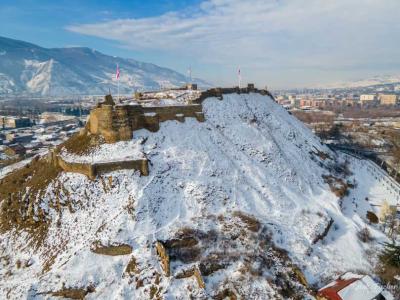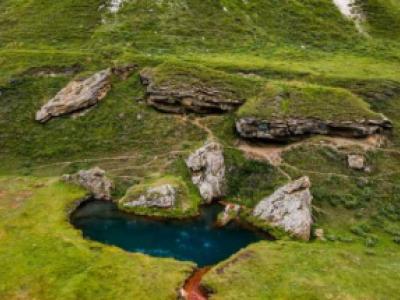Despite being an independent Europe-oriented country Georgia nowadays represents a big merge of its Soviet past and intervened modern architecture. Some disapprove this mixture, others clam it to be the pinnacle of the architectural masterpiece but no matter how much you argue there is no definite answer whether Georgia should have remained its Soviet architecture without implementing construction plans with lanky skyscrapers or maybe it would have been better to create a downtown center without any hints to the grim Soviet culture.
In order to embrace the whole grandeur of Soviet culture in Tbilisi it is crucial to move to its center – Liberty Square which is near to Sololaki district – place known as an archipelago of ancient discoveries including extraordinary and heavy buildings built in 1940s and even earlier.
The former National Bank of Georgia is situated in Leonidze Street that goes up Liberty Square. National Bank of Georgia is in 20 meters and from the first sight you understand that this building was built with a refined sense of taste. Erected in 1913, this grand grey building belonged to Tbilisi Mutual Credit Society but Soviet leaders confiscated it from the owners and bestowed it to the State Bank. Its façade is difficult to forget as it is picturesquely decorated with two naked athletes as if rising from the wall and supporting the whole building. During the 1950s the third storey was added to the bank which now stands for Money Museum. The museum represents all kinds of Georgian currencies existed starting from 4 B.C. along with Macedonian starter, Arabian drachmas, Venetian ducats and many other ancient coins. The building bears lots of secrets and once you pass the street your glance will definitely fall on the building. You will find it mysterious and unscalable, as if it had always stood there despite the fact that the bank was partly damaged after Soviet Union was dismantled (1991) though later it was restored.
The next destination is Machabeli Street famous for hosting Russian poets and writers throughout the beginning of the 20th century. The famous House of Writers situated in Machabeli Street makes the legends about big names like Maxim Gorki, Vladimir Mayakovski, and Alexei Tolstoy alive, as they were actively engaged in the meetings and operations in the 1920s held in Tbilisi. Erected in 1905, House of Writers first belonged to the Georgian patron of arts and activist David Sarajishvili who desired the building to be expressed in the style of ‘modern’. Once entering the building you will feel yourself in a big Soviet leaders’ mansion which looks strict but friendly at the same time. Nowadays Georgian Association of Writers often meets up in the building and the yard is occupied by art-café Littera which creates exquisite atmosphere making you feel part of the literature beau monde of the 20th century.
After having walked through the old part of the city let’s move to the busiest and the most famous parts of Tbilisi. The big yellow building which once used to be the Georgian Parliament at first seems to be emotionless and too plain bears a long and deep history of upheavals. Stone face of the building shows the remained Soviet stars and bullet marks as if showing respect to the victims of bloody history of Rustaveli Avenue.
The former Institute of Marx and Engels now belongs to Biltmore Hotel. Its architecture resembles the heavy style of the Parliament though thick columns create the feeling of a great impenetrable weight. There was a long and contradictory discourse concerning the future of the former Institute where some desired to destroy the building and create a fine modern hotel complex, whereas others could not let the historical building end up as the debris of the 21st century. Nowadays the reception of Biltmore occupies the whole building and at its back we can see a skyscraper with the hotel rooms.
One of the brightest examples of Stalin Neoclassicism is the Georgian National Academy of Sciences which is more recognizable by the artists who sell their works on the stairs altogether with Georgian enamel and souvenirs. The building has some gleams of Moresque style and does not look as gloomy as other Soviet-time masterpieces. Earlier there was a cable-car at the building’s territory which now is not functioning though there were rumors that government is thinking about re-opening it in the nearest future.
The current headquarters of National Bank of Georgia are strange but at the same time unique example of Soviet architecture. The building consists of a monumental grid of interlocking concrete forms built in a “post-constructivist” style. The Bank of Georgia added a glass cube that graces the view and makes it look less Soviet, though not many people even have a hunch that the Bank was built in the 20th century. In 2007 the building was given the status of an Immovable Building by the National Monuments Acts.
Another interesting building structure is situated near Tbilisi Sea zone – The Chronicle of Georgia, created by famous Georgian sculptor Zurab Tsereteli. Its construction began in 1985 but it is incomplete till the present day. The high columns depict the life of Christ and Georgian kings and queens, as if trying to capture the glimpse of Georgian history in one place.
A great portion of attention is paid to Tbilisi Metro with its Soviet to the core stations. The building of the metro began in 1966 and some old-timers claim that even the sulfur smell which you feel when entering the metro from the main doors has remained the same and some taxi-drivers still remember the old names like ‘Lenin Square’ instead of ‘Liberty Square’. Though the stations are alike a hawk-eye will definitely notice the differences between them without even announcements of the stations by the voice recorder.
There are lots of places in Tbilisi that let the older generation reminiscence about the Soviet past and this tour will definitely become an unforgettable memory if you are fond of strange and extraordinary architecture and want to make peculiar photos.




